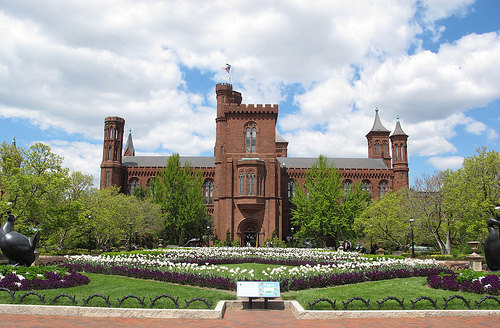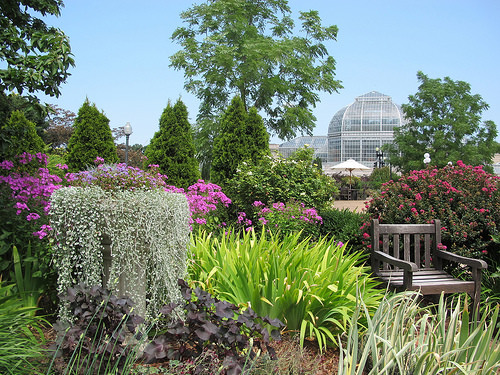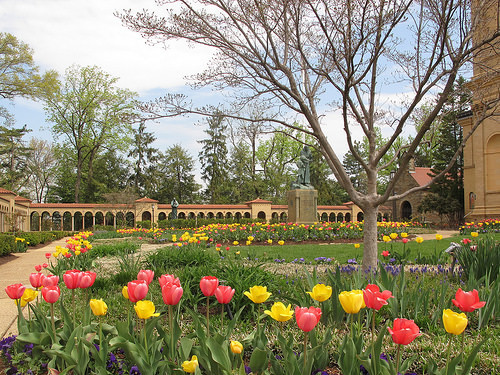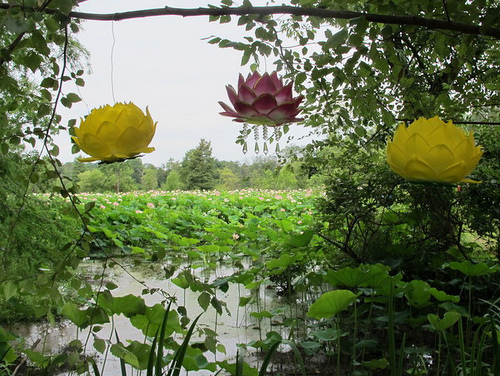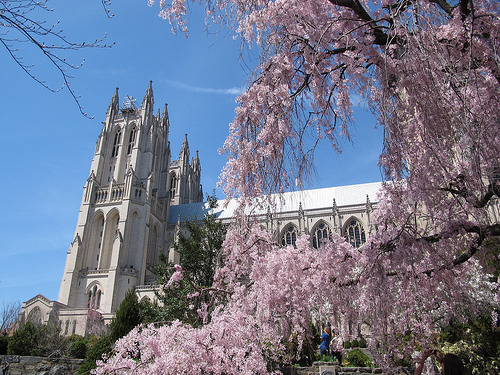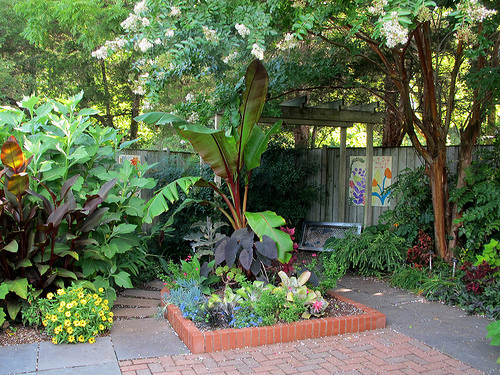Visit DC’s wonderful public gardens on transit
Our region is blessed with over 100 public gardens, most of which are free or very cheap to visit. Here’s a rundown of the very best, all of which you can get to by taking Metro or the bus.
Smithsonian Gardens
The easiest to access are the Smithsonian Gardens, a collection of gardens in and around many of the museums on the National Mall that counterbalance the dark halls of fossils and spacecraft.
The Smithsonian Gardens are comprised of 12 distinct spaces. They range from the Victory Garden, a recreation of a World War II vegetable and flower garden at the Museum of American History, to the contemporary Hirshhorn Museum and Sculpture Garden.
You can get to all of the Smithsonian gardens by Metrorail and bus, and they’re all free. A lot of them also host regular tours and other educational programming. The Mary Livingston Ripley Garden‘s tour, which is hosted by a horitculturist every Tuesday at 2 pm throughout October, is one of the best.
The US Botanic Garden
Also on the National Mall is the US Botanic Garden, a great place to enjoy native plants. In warm months, there is nothing more stunning than the blazing yellow-orange Amsonia with the National Museum of the American Indian in the background, and the glass conservatory is my place to get away from the long, dull gray of winter.
Mark your calendar: the Botanic Garden is open on both Christmas and New Year’s Day, and it hosts a holiday garden railroad display.
Because the Architect of the Capitol runs the Botanic Garden rather than it being part of the Smithsonian, it can close unexpectedly, like when it hosts fundraisers for legislators. Make sure to check before you visit!
Mount Saint Sepulchre Franciscan Monastery
If crowds aren’t your thing, check out the Franciscan Monastery in Brookland. I usually take the Metro to Brookland and walk the mile there, but the H6 and the 80 buses get you even closer.
The Monastery grounds are free and open to all. They are known for their fantastic bulb displays around Easter, but there are stunning roses in late May and early June, and later in the summer there are tropical gardens that even feature a few palm trees.
The National Arboretum
Not far from the Monastery is the National Arboretum. There used to be a Metrobus that served this garden, but it was infrequent and eventually ceased service a few years ago. Now, the best way to go is to take the B2 bus and walk in from the R Street entrance.
Among the Arboretum’s unique collections are the sun-filled Gotelli Dwarf Conifer Collection (dwarf being a very relative term) and Fern Valley, which is shady and full of ephemeral woodland wildflowersin the early spring. Also, the National Herb Garden includes hundreds of species of herbs and visiting is a scent-filled, interactive experience.
The Arboretum is run by the US Department of Agriculture, and in recent years it has been more about research than public outreach and education. But the new director, Dr. Richard Olsen, comes from a horticultural background rather than an administrative one, and local gardeners hope that means a change of focus.
The Arboretum is open every day of the year except Christmas. Recently, it was closed three days a week because of sequestration, but that didn’t last thanks to fundraising by Friends of the National Arboretum.
The Arboretum’s grounds are large and it would take several visits to see it all. Plan to visit often and in all seasons to see how the gardens change throughout the year.
Kenilworth Aquatic Gardens
Just across the Anacostia from the Arboretum are the Kenilworth Aquatic Gardens. You can actually get there by canoe easier than by transit, but I usually take the Metro to Deanwood and walk over.
Once there, you pretty much have the whole place to yourself. A former waterlily nursery now a national park, this is the true hidden oasis of the city.
The Aquatic Gardens are also a wildlife haven. Both photographers and birders frequent the gardens in the early mornings, leaving before the heat of the day. They are missing out though, as the hundreds of waterlilies and lotus open up in the direct midday sun. The best time to see them is during July and August.
The Bishop’s Close at the National Cathedral
The Bishop’s Close at the National Cathedral is accessible and open to all. To get there, take one of the many 30 buses that go up and down Wisconsin and get off when you see the looming spires.
The secluded, walled garden is downhill from the south-facing side of the Cathedral, giving it a great view of the building. The garden itself is sunny and bright, which helps the roses and English-style perennial borders grow, but there are also some shady, quiet spots.
Outside of DC
Farther afield, local parks systems run Brookside Gardens in Wheaton and Green Spring Gardens in Alexandria, both of which are free to enter. Reaching either by transit takes a combination of Metrorail and bus, but they’re both worth it if you’re looking for an afternoon outside of the city. Of course, better access by transit would make these gardens even more valuable to their surrounding communities.
There’s a lot more to gardens in DC than a once per year trip to see the cherry blossoms bloom. DC Gardens, a new local nonprofit, sprung up this spring to help spread the word about the city’s great public gardens to both tourists and residents. On DCGardens’ website, you’ll find month to month calendars for lots of our public gardens, along with listings for events, festivals, and activities going on at each.
This post originally said the US Botanic Garden closes unexpectedly to host fundraisers for legislators. In fact, the Garden doesn’t allow fundraisers of any kind.

